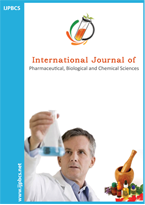LEAF DAMAGE IN JAMUN TREES ATTRIBUTED TO LEAF MINER INFESTATION Impact of Leaf Miner Infestation on Jamun Tree Foliage
Main Article Content
Abstract
The leaves of Jamun trees displayed symptoms such as oval or linear blisters, which later progressed into brown-colored blisters. Suspecting insect infestation, we conducted further investigation using a stereomicroscope and identified larvae within the affected areas of the leaves. To determine the insect species, the symptomatic leaves were placed in a test tube with moisture provided, and after 15 days, winged insects were observed and examined under the stereomicroscope. Based on their morphological characteristics, we identified the insect as Heliozela anna leaf miner, known to cause similar leaf damage in citrus and tomato plants.
Downloads
Article Details

This work is licensed under a Creative Commons Attribution-NonCommercial-ShareAlike 4.0 International License.
How to Cite
References
Akhtar, M. S., & Khan, M. M. (1994). Biology and bionomics of Heliozela anna Zell. (Lepidoptera: Heliozelidae) on guava. Pakistan Journal of Zoology, 26(2), 139-142.
Anonymous. (1986). Research Highlight, 1985, ICAR, New Delhi, P.27.
Bhattacharyya, A., Saha, S., and Gupta, S. (2018). First report of Heliozela anna (Lepidoptera: Heliozelidae) infestation on mango (Mangifera indica) from India. Entomology Research, 48(4), 324-328.
Biswas, S., Jana, S. K., & Bhattacharyya, A. (2018). First report of Heliozela anna (Lepidoptera: Heliozelidae) infestation on guava (Psidium guajava) from India. Entomology Research, 48(2), 131-134.
Butani, D.K. (1979). Insects and Fruits. Periodical Expert Book Agency, D-42, Vivek Vihar, Delhi 110032, 415.
Foba, C. N., Salifu, D., Lagat, Z. O., Gitonga, L., Akutse, K. S., & Fiaboe, K. K. M. (2015). Species composition, distribution, and seasonal abundance of liriomyza leafminers (Diptera: Agromyzidae) under different vegetable production systems and agroecological zones in Kenya. Environmental Entomology, 44(2), 223-232. https://doi.org/10.1093/ee/nvu065.
Geetha, C.K., Babylata, A.K., Methew, K. L., & George, S.T. (1992). Fruit development in jamun (Syzygium cuminii Skeels). South Indian Horticulture, 40, 350-351.
Haldhar, S.M., Deshwal, H.L., Jat, G.C., Berwal, M.K., & Singh, D. (2016). Pest scenario of ber (Ziziphus mauritiana Lam.) in arid regions of Rajasthan: a review. Journal of Agriculture and Ecology, 1, 10-21.
Hebbara, M., Manjunatha, M.V., Patil, S. G., & Patil, D.R. (2002). Performance of fruit species in saline-water logged soils. Karnataka Journal of Agricultural Sciences, 15, 94-98.
Joshi, R.C., Rao, P. Kameswara., & Ali, M. H. (1981). Preliminary Studies on Jamun Leaf Miner (Antispila anna Meyr.) With Two New Parasite Records. Current Science, 50(8), 373–374.
Khanna, V., & Kumar, R. (2016). Infestation of Heliozela anna Zeller (Lepidoptera: Heliozelidae) on guava in Uttarakhand, India. Indian Journal of Entomology, 78(2), 141-143.
Kumari, N., Devi, L., & Sharma, R. (2017). New report of leaf miner Heliozela anna (Lepidoptera: Heliozelidae) infestation on papaya (Carica papaya L.) in India. International Journal of Agriculture Sciences, 9(22), 4665-4667.
Mohammed, M., & Wickham, L. (1999). Effect of modified atmosphere packaging and ethanol on the deastringency process in Jamun (Syzygium cuminii Skeels) fruit. Journal of Applied Horticulture, 1, 105-107.
Prince, P.S.M., Kamalakkannan, N., & Menon, V.P. (2003). Syzygium cuminii Skeels seed extracts reduce tissue damage in diabetic rat brain. Journal of Anthropology, 84, 205-209.
Sahoo, P. K., Misra, R. C., & Patnaik, H. P. (2019). First report of Heliozela anna (Lepidoptera: Heliozelidae) infesting jamun (Syzygium cumini) in India. Journal of Entomological Research, 43(3), 441-444.
Sahoo, P. K., Misra, R. C., & Patnaik, H. P. (2019). First report of Heliozela anna (Lepidoptera: Heliozelidae) infesting jamun (Syzygium cumini) in India. Journal of Entomological Research, 43(3), 441-444.
Shukla, J. P. (1979). Ph.D. Thesis, Department of Horticulture, CSA University of Agriculture and Technology, Kanpur.
Singh, A.K., Bajpai, A., Singh, V.K., & Ravishankar, H., Tondon, D.K. (2009). The Jamun (Syzygium cuminii Skeels). Technical Bulletin, Central Institute for Subtropical Horticulture (ICAR) Lucknow, 20-21.
Singh, I.S. (2001). Minor fruits and their uses. Indian Journal of Horticulture, 58, 178-182.
Singh, S. K., & Sinha, B. P. (2008). Life history and bionomics of Heliozela anna Zeller (Lepidoptera: Heliozelidae) on guava. Journal of Entomological Research, 32(3), 201-204.
Singh, Sanjay, & Singh, A.K. (2006). Standardization of method and time of propagation in Jamun (Syzygium cuminii) under semi-arid environment of western India. Indian Journal of Agricultural Sciences, 76, 242-245.
Srivastava, R. K., & Khare, S. K. (2013). Biology and management of leaf miner Heliozela anna Zeller (Lepidoptera: Heliozelidae) infesting mango. Indian Journal of Entomology, 75(4), 369-374.
Venkatesan, T., & Manickavasagam, S. (2017). Heliozela anna – A new pest of guava in India. Pest Management in Horticultural Ecosystems, 23(1), 51-52.
Via, S. (1984). The quantitative genetics of polyphagy in an insect herbivore. I. genotype-environment interaction in larval performance on different host plant species. Evolution, 38(4), 881. https://doi.org/10.2307/2408398.
Zia-ul-Haq, M., & Khan, A. H. (2012). Record of a new host plant, papaya (Carica papaya L.), for Heliozela anna Zeller (Lepidoptera: Heliozelidae). Journal of Applied Horticulture, 14(1), 76-78.
